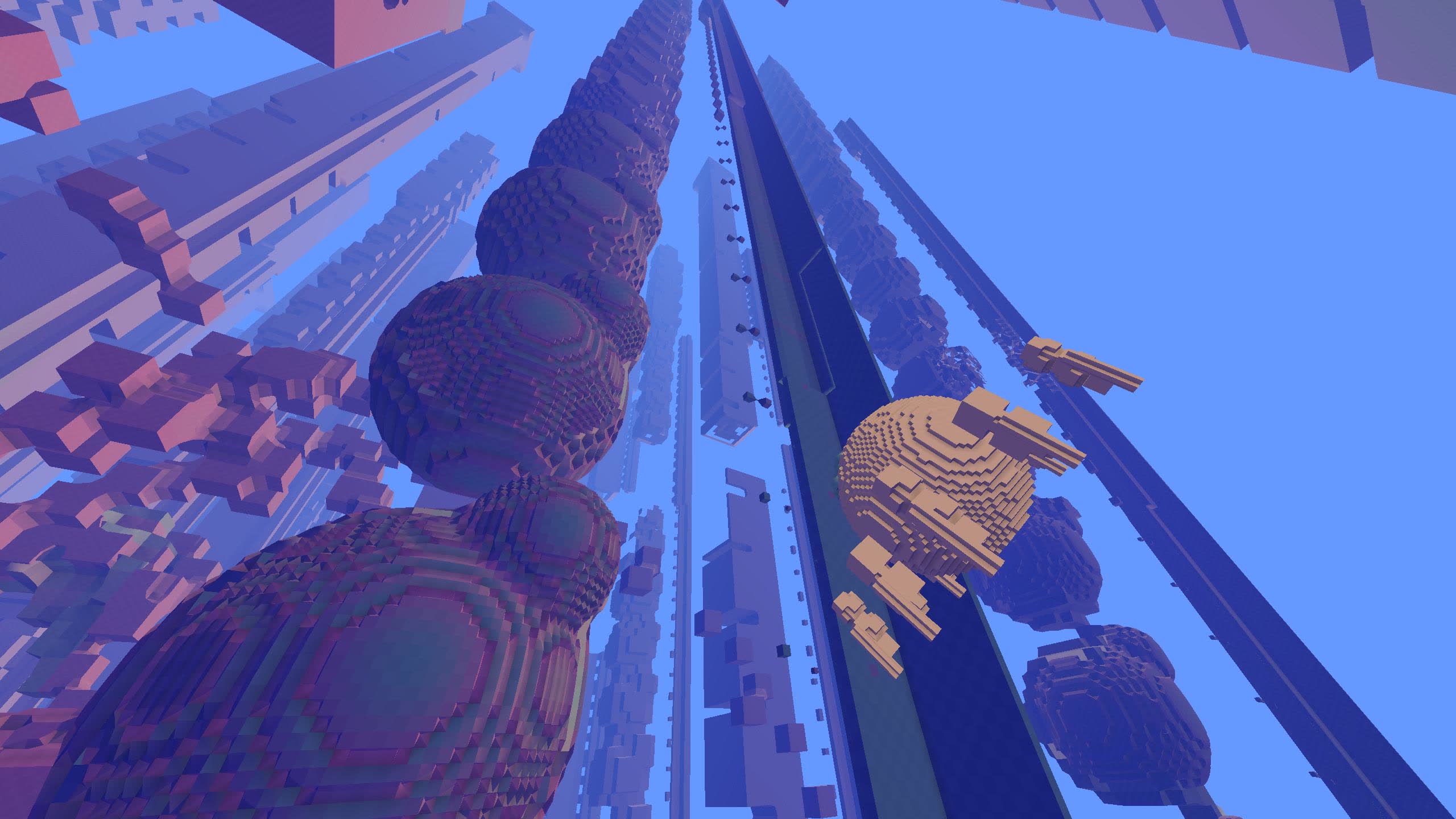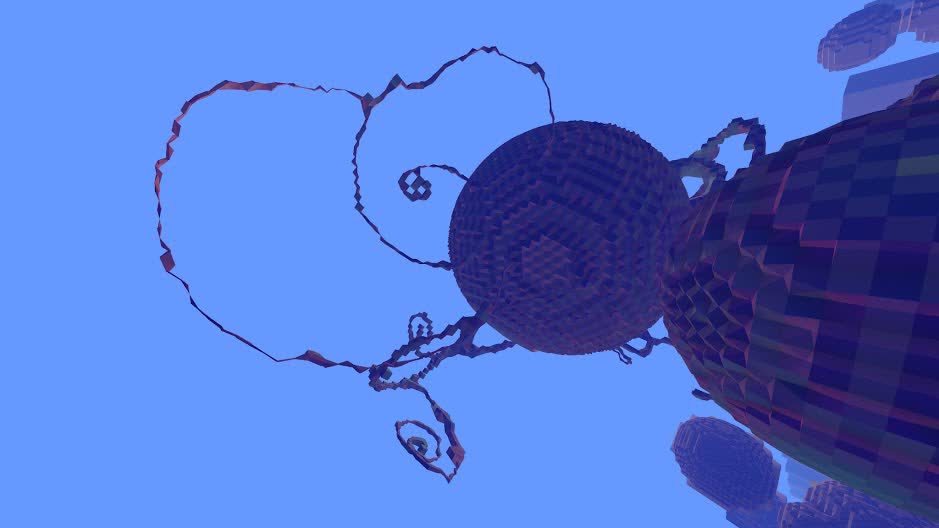Interview: Avoyd

It's scrawled on the whiteboards of large production houses like a dry-wipe commandment. Unquestioned, omnipotent, it's treated as a precious axiom of the craft.
Its sentiment goes something like this: Software bugs are bad and should be beaten back into shape. They're mistakes to be removed, hunted like fugitives with large bounties upon their heads, ideally being condemned to an obituary.
Doug Binks and Juliette Foucaut of enkisoftware don't share this widespread attitude towards bugs prevalent among most videogame studios. Instead, they're delighted by the serendipity of bugs and treat them as if precursors guiding them down more interesting paths, straying from the beaten track. They choose to learn from their 'mistakes' rather than trying to delete all-known history of them.
"Avoyd is probably the first game outside of 'god games' to let players destroy and build their environment."
Once, while performing a network test of the duo's current project, the online multiplayer shooter Avoyd, a bug caused the player's avatar to misalign with the first-person view. This resulted in a vertical red arc to appear on the screen that shouldn't be there (see this image). Rather than squishing this bug and forgetting about it, Doug and Juliette were inspired to create "orbiting belts" around the avatars to support the UI, showcasing the weapons and tools the player had available to them.
Another time saw Doug posting a screenshot on Twitter of a bug that had caused black triangles to spread across the fractal landscapes in Avoyd. He did this not out of passionate contempt, but because he found the accidental effect pleasing to the eye. From this came an exchange with Paul Taylor, who leads the videogame studio Mode 7 Games, and who has also dabbled in producing electronic music under the name "nervous_testpilot" for the past 15 years. Paul wanted to use the repeated patterns of Avoyd's alien geometry as a visual accompaniment to a track from his Steel and Glass EP. All parties agreed to the notion, and so Juliette created a flythrough video of Avoyd's stochastic universe. The result is a sensuous blend of audio and visuals, black triangles included.
Doug and Juliette's appreciation of bugs goes deeper than spawning these tangential delights. It's the acknowledgment that the mistakes we make have great creative potential that has formed the framework of their game Avoyd. That, and its 15 years of development, is what make the game worth documenting.
End of the beginning
Avoyd is an abstract, six-degrees-of-freedom (6DoF) online multiplayer shooter. Work started on it back in 1999 and it was initially sold as shareware in 2000 until 2003 (you can download 1999 Avoyd for Windows here), halting due to Doug beginning full-time work for another studio. Considering those dates, Doug and Juliette believe that Avoyd is probably the first game outside of 'god games' to let players destroy and build their environment. It even pre-dates Red Faction, and certainly Infiniminer and the game it inspired in Minecraft. However, it was Minecraft's success that helped to justify Doug and Juliette's interest in restarting work on Avoyd in 2013.
"When we first heard of Minecraft it was already very successful; we were stunned by the similarities with Avoyd. We realized that, although we'd gotten a lot wrong, perhaps our main error was in not finishing what we started. So, Minecraft was awesome for us as it gave us the confidence that we wouldn’t be alone enjoying Avoyd, and that eventually we might be able to make a modest living from independent games development."
With newfound inspiration, Doug and Juliette started to build Avoyd once again, but this time the software and digital distribution models available suited their idea much better. They'd also had an extra decade of influences to draw from in creating Avoyd's look and lore. The game's current blend of colors is derived from their love of Jean Giraud's Mœbius, and early 2000AD comic series' such as Halo Jones and Nemesis the Warlock. They've also been inspired by the works of Osamu Tezuka, Leiji Matsumoto, and Hayao Miyazaki (in particular: Nausicaä, Princess Mononoke, and Spirited Away) to "create worlds people care about and want to inhabit."
"we like to focus on games which challenge our concept of space"
Even though Avoyd's currently wearing "debug visuals", it's a wonder to look upon such gargantuan clusters of abstract geometry. Fortunately, it seems as though this visual style won't be entirely erased as more features are added. It allows for a readable landscape, and that's an aspect that Doug and Juliette are keen to maintain: "The challenge is how far we can go down the abstract root whilst keeping the world understandable and self-consistent?"

Avoyd's new technological foundations and visual panache hasn't come at the cost of losing its roots in videogames of the '90s. It still has the twitch shooter spirit found in classic titles like Quake. In Avoyd, players are able to move with impressive dynamism: Clinging to surfaces, jumping to traverse gaps, and at any point they're able to switch to a flight mode with or without inertia. Getting to grips with this fast-paced 6DoF movement isn't easy, and as players of Parallax Software's Descent (a seminal videogame for 6DoF movement) will attest, it can lead to some uncomfortable stomach churning. While making players puke isn't a goal that Doug and Juliette have in mind, they do hope that players feel challenged by Avoyd's locomotion when navigating the environment, as that provokes creativity. This is a goal they acquired due to their experiences outside of videogames.
"Doug was an academic researcher in Physics before making a full time career out of his hobby of making games (which he's been doing since the ZX81 days), and one thing he'd noticed was that the better students and researchers tended to be able to visualise abstract shapes in 3D well. So we like to focus on games which challenge our concept of space - an early idea for Avoyd was to make the space a Tesseract (the original game has a hidden mode in which the space wraps around in each axis, but it's not a Tesseract)."
Giving players the ability to edit the malleable terrain to their advantage (and to their opponents' disadvantage) is also part of the duo's vision to have players question 3D space. This has since become a foundational aspect of what Doug and Juliette call "First-Person Editors", which have risen in popularity after Minecraft happened. So, while Avoyd may not be a unique concept any more—as it was more than a decade ago—it still has many features that Doug and Juliette are developing that will be.
Part of the culture

The intent behind Avoyd is for "twitch gameplay [to] live alongside strategy." This tactical play, this strategy, is found in shaping the contours of Avoyd's abstract universe. Every surface and every shape is susceptible to manipulation and utilizing this should be part of each competitor's repertoire. Perhaps they'll create walls to hide behind, or holes to dive in and out from, for instance. That's quite basic environmental destruction and recreation, and is seen in videogames like Build and Shoot, Guncraft, and Space Engineers already.
Where Avoyd separates from those other games begins with, oddly enough, the late Scottish sci-fi author Iain M. Banks. You see, Juliette and Doug have paid homage to him through naming one of Avoyd's most interesting environmental properties 'cultures' (The Culture is a utopian society that acts as the appending facet across a series of Banks's sci-fi novels and stories).
"Player Avatars are allied with a culture which they need to help propagate through the environment to meet their goals, and other cultures can be neutral, aggressive, or even helpful towards the player's culture.
Cultures create an asymmetry in how material reacts, as materials inhabited by your culture can be easily modified, but materials of other cultures less so."
There are also "Culture Nodes" (inspired by science fiction entities like Peter F. Hamilton’s incredibly hostile alien intelligence MorningLightMountain) that are capable of creating player Avatars and mobile units called Drones. These Nodes are spawn points and the territory around them is important for players to defend, otherwise the enemy will dominate the match.
"It's a game of constant trial-and-error, both for players and its creators."
Cultures imply that the environment is, in fact, a biomechanical substance and that it is multifaceted in a manner that encourages players to battle for territory. The technology that Juliette and Doug have built to develop Avoyd with is able to procedurally generate structures and enables them to chisel it to how they desire on a large scale. They're thinking of allowing some player cultures the opportunity to grow structures dynamically during the game. If that happens, it will be possible for players to build structures freehandedly during matches if they choose. However, a more accessible method of using this feature is to use blueprints.
"They allow players to easily make things in game, as selecting a blueprint and placing it in the environment gives you a form you can dump material in to create the object. If you place your blueprint adjacent to a material with your own culture it will automatically grow."
While a selection of blueprints will be pre-made by Juliette and Doug, players will also be able to create their own. They'll be able to do this in the "edit mode" (which has all the tools Doug and Juliette use to make levels), away from any hostility and other pressures. This also neatly ties together the two different gameplay modes as players can take the lessons learned from online matches and apply them when creating new blueprints in the editor, which they can then test out online, and so it goes. Once again we see a space for players to experiment, make mistakes, and improve their play. It's a game of constant trial-and-error, both for players and its creators.
Players can further take agency over their playstyle by turning the editing gun on themselves, as it were.
"The base Avatar is lightweight and fairly fast in all movement modes, but players can choose to build up their armour and surface movement, or concentrate on upgrading their flight systems. Avatar size is limited only by available materials, but there are trade-offs to make in going massive."
They haven't detailed what those trade-offs are yet, but cuts to your agility, as well as becoming a bigger target to shoot, seem like obvious ones. What may be a more exciting notion here, is that Doug and Juliette don't actually know what these trade-offs might be themselves, not yet.
Trial and error
Doug and Juliette say that they're building features and systems that allow for depth to emerge from them, whether that be a semi-planned result or an accidental bug that sparks an idea.
This is why creating Avoyd is a slow process—they can't always predict if a set of features will gel together to produce something that is fun to play with (and it seems they prefer it that way). Right now, they have a number of design ideas and are working them all out as they progress. Some will stay, while many others will be chucked out if they don't add significant dynamics to the play.

It's this lack of stability that necessitates Avoyd not being publicly playable yet. It might seem surprising that Doug and Juliette are keeping a game that primarily serves to be an online multiplayer experience to themselves, even this early on. If that thought occurred to you, it's no doubt due to the current popularity of alpha-funding models and, especially, Early Access (if the two are even distinguishable). Their problem is that it's much harder for them to take features out than it is to put them in, especially, once the game is released in any form. They want to make sure they've got solid groundwork to build upon rather than switching it out while people attempt to play it. It makes sense.
Even so, they're eager for people to play Avoyd and provide them with feedback. They're so excited for it that they're already "giving back" to the community.
"Doug founded and maintains Runtime Compiled C++ (RCC++, which is used by our friends who develop the AI middleware Kythera) and has made contributions to GLFW, NanoVG, OpenAL Soft, libRocket and APItrace as well as helping out fellow indie devs. Juliette helps with testing and documentation of RCC++, along with maintaining a Google App Engine (GAE) port of presskit() and helping people who want to use GAE as a free way to run a website."
There's a shortlist of services that you can make use of right now, then. Don't say they didn't ever get you anything! Joking aside, there's certainly much more to take away from this talk with Doug and Juliette. Their open-mindedness, specifically towards bugs (and everything else in life), has led to them adding features to Avoyd that they probably wouldn't have otherwise even thought about.
It's this philosophy that should rub off on players of Avoyd that want to excel at its eclectic mix of Quake, Descent, and Minecraft, as well as its unique environment shaping properties. When it does enter the public sphere for the first time, it should be interesting to watch how the community grows, what it discovers, and how it molds the direction that Doug and Juliette take it in.


